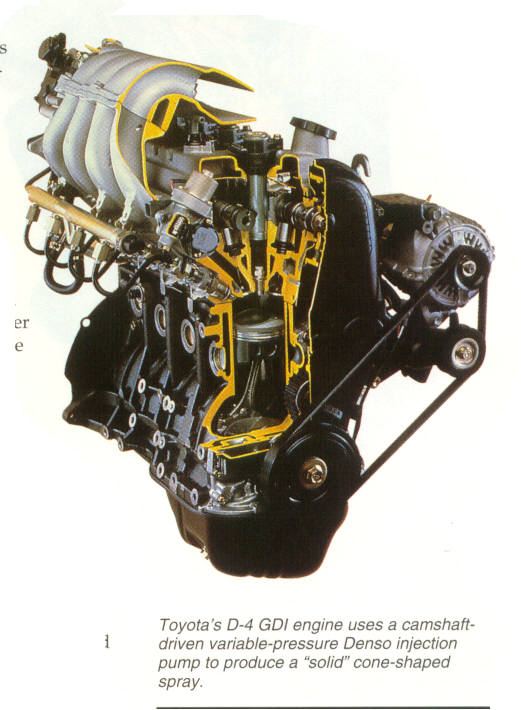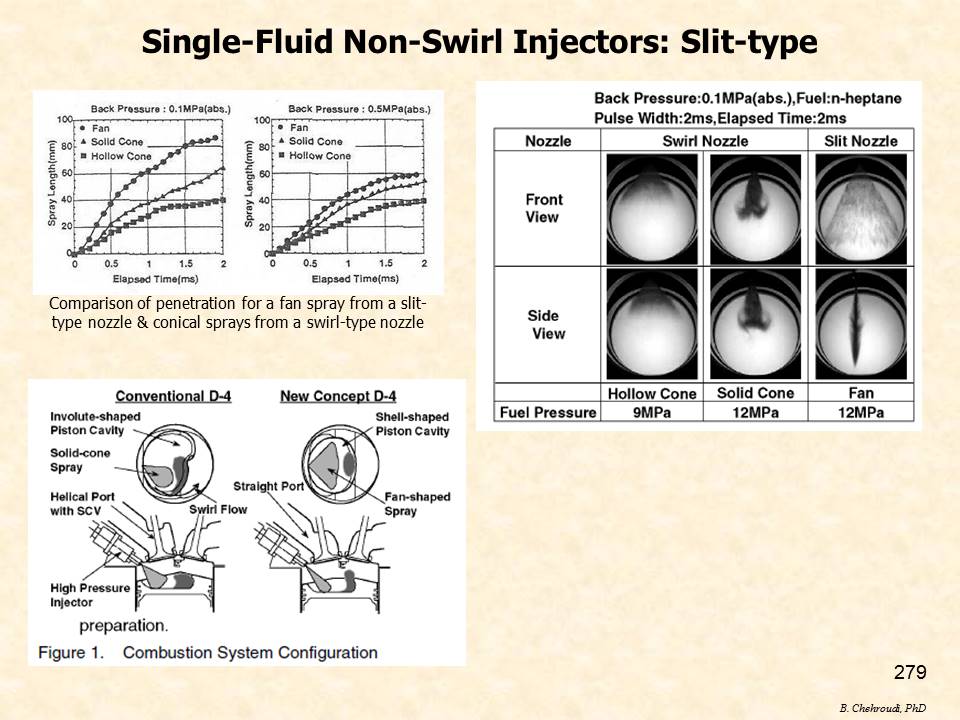|
Gasoline Direct Injection (GDI) Engines: Reasons, Operation, and
Potentials |
 |

The quest for an even
more efficient, smarter, and environmentally-cleaner
liquid-fueled spark ignition (SI) reciprocating engine than
the current multi-port fuel injection (MPFI) SI engines is
more alive and intense now than ever before. In this effort
the GDI SI engines have an important and special place. Some
background information is of value to facilitate the
understanding of the operation and potentials of the GDI
engines. The history of the fuel/air mixture preparation
system in SI engines starts with the carburetor units
positioned in the intake system just prior to the throttle
valve which itself is connected to the driver accelerator
foot-pedal for manual load (or engine output torque and
power) changes in these engines. For many years this served
the purpose until the race for the higher performance, more
fuel efficient, and cleaner-burn engine intensified that led
to the MPFI SI engine design. In this design, an
electronically-controlled fuel injector is used per each
cylinder for fuel metering and targeting of the sprays
towards the intake valves. In MPFI engines the amount of
fuel injected can be independently controlled from the air
flow and the replacement of the carburetor unit by the port
injectors itself caused a better breathing capability (or
higher so-called volumetric efficiency) of the engine
leading to higher output torque and power levels. Higher
volumetric efficiency means that each cylinder of the engine
can bring more mass of air thereby providing the potential
and opportunity for more fuel introduction and hence higher
chemical energy release per cycle delivering a higher engine
torque. In contrast, diesel engines use direct liquid fuel
injection into the cylinder and rely on autoignition of the
fuel itself with no external ignition sources such as spark
plug or any other means. The load in these engines are
varied by changes in the amount of the fuel injected and
there are no throttle valves in the intake system.
Therefore, the pumping work, a negative work or energy
needed to pump air in and burned gases out of the cylinders,
are nearly zero for diesel engines whereas it changes from a
maximum value, at idle throttle valve position, to a
negligible amount under full load at wide open throttle (WOT)
valve position in SI engines. Note that the net indicated
output work of an engine is equal to the total work during
the compression and expansion strokes minus the pumping
work. Pumping work is also referred to as throttling work
losses in the automotive literatures. The absence of the
throttling work losses (as a result of the lack of the
throttle valve) for the direct injection (DI) diesel engine
is also one significant advantage of the GDI engine design.
This provides an opportunity for improvement in specific
fuel consumption (SFC) over the current MPFI engines. In a
sense a GDI engine is like a DI diesel engine but with a
suitably-positioned spark plug and a gasoline fuel, instead
of the easily auto-igniting diesel fuel, in-cylinder
injection system. In practice, some degree of throttle
control is usually required for GDI engines, compromising
the SFC improvement potential.
Full potential of the GDI
engine can be harnessed if ...
Learning
Objectives:
Upon completion of this seminar,
you will be able to:
-
Describe the rationale
behind the GDI engine
operation
-
Analyze the important
processes in GDI engines
-
Explain liquid atomization,
sprays, and injector
requirements for successful
GDI operation
-
Utilize the technology and
the logic behind gasoline
direct injection
-
Estimate and predict effects
of key engine design and
operating conditions on
performance, combustion, and
emission in GDI engines
-
Communicate effectively with
engineers working on fuel
injection, combustion and
emission aspects of the GDI
engine in your firm or with
customers
-
Effectively contribute to
the design of critical
components such as
combustion chambers,
injectors, and emission
reduction strategies
-
Explain and utilize
trade-offs between
increasing engine
performance and maintaining
low emission characteristics
Who Should Attend:
This seminar will be especially
valuable for engineers,
technical and project managers,
researchers, and academicians.
Engineers working on the design
of components for high
efficiency and performance of
GDI engines as well as those
directly and indirectly involved
in mixture preparation and
emission reduction of harmful
pollutants from these engines
will highly benefit from this
course. Environmental engineers
desiring to expand their
understanding of fuel spray
formation, combustion and
emissions from GDI engines will
benefit, as well as, engineers
active in the development and
application of software for the
modeling and design of
combustion chambers, fuel spray
dynamics, combustion and
emission issues.
How to Arrange for a Presentation:
Due to ATC's low overhead,
direct-contact clients are offered a competitive and
cost-effective package. Individuals interested in these seminars should contact Advanced Technology Consultants (ATC)
directly. Alternatively, this seminar (prepared by the ATC
and delivered by a award-winning ATC consultant) are also
sponsored by the Society of
Automotive Engineers (www.SAE.org).
seminars should contact Advanced Technology Consultants (ATC)
directly. Alternatively, this seminar (prepared by the ATC
and delivered by a award-winning ATC consultant) are also
sponsored by the Society of
Automotive Engineers (www.SAE.org).
Electronic and hard
copies of the seminar materials can be purchased and are
only available through ATC. Contact ATC for price and
shipping.
NOTE:
Professionally-prepared "audio-video Powerpoint-type
presentations" of these seminars are available for purchase
by the companies. Each slide is presented with a clear audio
by the consultant, describing the subject, while a digital
pointer guides the audience to where the attention is to be
focused. Companies can put such audio-video presentations on
their intranet to be used by their employees. It is a cost
effective way of approaching professional training which
also contributes towards R&D, design, and intelligent new
product development. Presentations are updated every year at
a fraction of the original cost.
For a sample presentation click on the word "INJECTION" in
the picture
to get a feel of how information is
transferred
(High-speed internet access is recommended.
Otherwise, download may take a few more minutes). For more details and
pricing please contact ATC.
List of topics discussed in the
seminar:
Testimonial:
"It covers every possible attendee, from the one that wants
only an overview to the one that needs the most deep detail
of GDI engine. Worth the trip I made from Greece. "
Savvas Savvakis
PhD Researcher
Aristotle University of Thessaloniki

Instructor: Bruce
Chehroudi
Dr.
Chehroudi, has accumulated years of
technical and leadership experiences in different capacities
and organizations. This includes such positions as a
Principal Scientist and Group Leader appointment at the Air
Force Research Laboratory (AFRL) ERCInc, a Chief Scientist
at Raytheon STX, a Visiting Technologist at Fordís Advanced
Manufacturing Technology Development (AMTD) center, a
tenured Professor of Mechanical Engineering at Kettering
University and University of Illinois, and served as a
Senior Research Staff/Research Fellowship at Princeton
University. Dr. Chehroudi directed numerous multimillion
dollar interdisciplinary projects in areas involving
chemically reacting flows, combustion and emission of
pollutants, sustainable and alternative energy sources,
distributed ignition, material/fuel injection, advanced
pollution reduction technologies, propulsion concepts, gas
turbine and liquid rocket engines, combustion instability,
laser optical diagnostics, spectroscopy, supercritical
fluids and applications in environmental and propulsion
systems, advanced composites, MEMS, nanotechnology, and
micro fluidics. He has won many merit and leadership awards
by such prestigious organizations as the Society of
Automotive Engineers (1. Arch. T. Colwell Merit Award
for technical excellence only to top 1% yearly, 2. Ralph
R. Teetor Award for outstanding
teaching/research/leadership, 3. Forest R. McFarland
Award for sustained leadership in professional and
educational service and a key contributor to the Continuing
Professional Development Group, 4. Appreciation Award for 10
years of dedicated and inspiring service and
commitment to providing quality technical education, and
5. Outstanding Faculty Advisor),
American Institute of Aeronautics and Astronautics (Best
Publication Award of the Year), Air Force Research
Laboratories (1. Outstanding Technical Publication Award,
and 2. STAR Team Award for demonstrating world-class
combined scientific and leadership achievements), Institute
of Liquid Atomization and Sprays Systems (Marshall Award
for best publication with lasting contributions), Liquid
Propulsion Sub-committee of Joint Army-Navy-NASA-Air Force (JANNAF)
(Best Liquid Propulsion Paper Award involving
undergraduate/graduate students), and the 2nd
International Symposium on Turbulence and Shear Flow
Phenomena (Top 10 Technical Publication Award). He has been a consultant
with many organizations such as, Ford, GM, Honda R&D, AFRL,
Honeywell, NASA, AFOSR, VW, Bosch, Siemens, NGK, Cummins,
and TRW. Through professional societies, Dr. Chehroudi
delivers invited professional seminars on Management of R&D
Teams and Organizations, Management of Innovation,
Combustion and Emission of Pollutants in Automotive and Gas
Turbine Engines, Ignition Issues, Gasoline Direct Injection
engines, R&D on Homogeneously-Charged Compression Ignition (HCCI)
engines, and Liquid Injection Technologies. He has a PhD in
Mechanical & Aerospace Engineering and Post-Doctoral Fellow
(Princeton University), MS in Mechanical Engineering
(Southern Methodist University, Summa Cum Laude), MS
in Economics (Swiss Finance Institute, Magna Cum Laude),
a senior member of American Institute of Aeronautics and
Astronautics Propellant & Combustion Committee
(2008-present), and is an Associate Fellow of American
Institute of Aeronautics and Astronautics. Dr. Chehroudi
acts as a reviewer for many scientific and engineering
journals and publishers, has delivered over 200
presentations in technical meetings and to nontechnical
audiences, over 20 technical reports (Princeton University,
General Motors, Ford Motor Co, Department of Energy, NASA,
Air Force Research Laboratory), five 600-plus-page monographs on
combustion and emission of pollutants from mobile power
plants, ignition technologies, liquid material injection, and
nanotechnology, two book chapters on propulsion system
combustion instability and applications of graphene (a
nanotech product) in ignition and combustion of fuels,
ground-breaking patents on applications and synergy between
nanotechnology, light, and chemical reaction for a
light-activated distributed ignition of fuel-air mixtures, and
has more than 150 publications with extensive experience in both
scientific and management areas and intensive trainings in
finance and financial engineering
Back to Top of This Page
NOTE:
Contact Advanced Technology Consultants for
consulting needs and opportunities in this area
Copyright 2015 -
Advanced Technology Consultants- All Rights
Reserved
|
|




